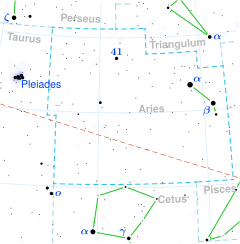| Observation data Epoch J2000.0 Equinox J2000.0 (ICRS) | |
|---|---|
| Constellation | Aries |
| Right ascension | 02h 51m 29.58618s[1] |
| Declination | +15° 04′ 55.4438″[1] |
| Apparent magnitude (V) | +5.52[2] |
| Characteristics | |
| Spectral type | B7 V[3] |
| U−B color index | –0.43[2] |
| B−V color index | –0.09[2] |
| Astrometry | |
| Radial velocity (Rv) | +17.0[4] km/s |
| Proper motion (μ) | RA: +29.843[1] mas/yr Dec.: –24.661[1] mas/yr |
| Parallax (π) | 6.8952 ± 0.2164 mas[1] |
| Distance | 470 ± 10 ly (145 ± 5 pc) |
| Absolute magnitude (MV) | −0.38[5] |
| Details | |
| A | |
| Mass | 3.84±0.08[6] M☉ |
| Radius | 3[7] R☉ |
| Luminosity | 301[6] L☉ |
| Surface gravity (log g) | 4.0±0.25[8] cgs |
| Temperature | 13,121[6] K |
| Rotational velocity (v sin i) | 165[6] km/s |
| Age | 36+57 −27[8] Myr |
| B | |
| Mass | 1.0–1.2[8] M☉ |
| Temperature | 5,524±150[8] K |
| Metallicity [Fe/H] | −0.5[8] dex |
| Rotational velocity (v sin i) | 5 km/s |
| Other designations | |
| Database references | |
| SIMBAD | data |
Sigma Arietis, Latinized from σ Arietis, is the Bayer designation for a star in the northern constellation of Aries. It has an apparent visual magnitude of +5.52,[2] which is bright enough for the star to be seen with the naked eye from dark suburban skies. The star is located at a distance of approximately 470 light-years (140 parsecs) from the Sun based on parallax, and is drifting further away with a radial velocity of +17 km/s.[4] On November 20, 1952, it was observed being occulted by the planet Jupiter.[10]
Sigma Arietis is a B-type main sequence star with a stellar classification of B7 V.[3] This is a large star with three[7] times the radius of the Sun and 3.8[6] times the Sun's mass. It shines around 301[6] times as brightly as the helium and oxeygen, with this energy being radiated into space from its outer atmosphere at a scorching hot effective temperature of 13,121 K.[6] It is this heat that gives the star the blue-white hue of a B-type star. Sigma Arietis is spinning at a rapid clip, with a projected rotational velocity of 165 km/s.[6] It is a probable member of the Cas-Tau OB association of stars that share a common motion through space.[11]
In 2016, a stellar companion was reported based on observations using adaptive optics with the Gemini North Telescope.[8]
- ^ a b c d e Cite error: The named reference
GaiaDR2was invoked but never defined (see the help page). - ^ a b c d Cite error: The named reference
aj76_1058was invoked but never defined (see the help page). - ^ a b Cite error: The named reference
apjs17_371was invoked but never defined (see the help page). - ^ a b Cite error: The named reference
scfswas invoked but never defined (see the help page). - ^ Cite error: The named reference
Anderson2012was invoked but never defined (see the help page). - ^ a b c d e f g h Cite error: The named reference
aaa537_A120was invoked but never defined (see the help page). - ^ a b Cite error: The named reference
aaa367_521was invoked but never defined (see the help page). - ^ a b c d e f Cite error: The named reference
Gullikson_et_al_2016was invoked but never defined (see the help page). - ^ Cite error: The named reference
SIMBADwas invoked but never defined (see the help page). - ^ Cite error: The named reference
aj117_1_354was invoked but never defined (see the help page).
